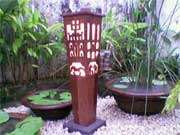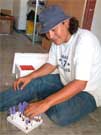By Elizabeth Pisani
941 words
6 November 1989
Reuters News
English
(c) 1989 Reuters Limited
MOUNT MERAPI, Indonesia, Nov 6, Reuter - Tigers invading the villages, ants swarming out of the ground and hundreds of thousands of dollars of high-technology equipment drawing wiggly graphs.
This is all the warning the world is likely to get that one of its most active volcanoes, bang in the middle of a densely populated area, is about to erupt.
Mount Merapi, in the fertile heart of Java, is the most closely watched of the 129 active volcanoes that dot Indonesia's island arc and give it its ominous nickname, "The Ring of Fire."
Merapi last erupted in 1984. Since then it has been busily building up a dome of hardened lava that is now five times as big as when it last blew. What's more, seismic activity, rumblings of above four on the Richter scale, have in the past few months jumped from one a day to around 65.
The temperamental volcano erupts every few years.
"Now we're really waiting for the big one," said Irwan Bahar who heads the Merapi Observatory in Jogjakarta, the ancient seat of Javanese culture, which nestles uneasily 30 kms (20 miles) southwest of the volcano.
Just now the crushing weight of the lava dome is about equal to the upward pressure of the molten rock, or magma, inside the volcano. If that delicate balance is upset, the fireworks could start.
The onset of Java's violent rainy season this month, coupled with the seismic activity, might just do the trick.
"I'm scared of these next few months. If heavy rains and the tectonic movements shift a bit of the dome, it could trigger the magma and blow the whole lot," Irwan said.
He said over 10 million cubic metres of rock, dust and volcanic mud could shower down on the villages and rice paddies around the base of the mountain.
The government forbids settlement for 10 kms (six miles) around the mount. But volcanic ash makes for fertile fields that local peasants do not pass up easily, and clearing the zone of people is tough.
"Of course they clear out while we are looking and come back later on," Irwan said.
Villagers are well aware of the danger. An elaborate tom-tom network beats out warnings relayed from observatories, and there is an official evacuation drill once a year.
Added to that, natural warnings are deeply rooted in local folklore. "When the ants come up, we know we must watch out, the mountain is getting hot," said a local farmer. "And when the tigers come down, that really means trouble."
Volcano watchers, most of them local people employed by the government to slog up Merapi every few weeks, take photographs and measure gas temperatures, are not all sceptical of the folklore.
"It's true there are tigers on the south side, and before the 1984 eruption they were seen in the villages," said Sumiti, a 59-year-old volcano watcher who has been climbing Merapi for 30 years.
Past eruptions have broken down the southwest side of the crater facing Jogjakarta, providing a neat lip from which material could pour down valleys and river beds towards the city.
A Japanese-financed dam-building project is designed to guard against vast, slow flows of volcanic mud bearing down on Jogjakarta.
But, says Jean-Christophe Sabroux, a French vulcanologist at the Vulcanological Survey of Indonesia in Bandung, "If the whole thing blows up, it could happen in hours. The dams won't do a thing in that case."
The prospect of a snap eruption looms large over those that try to predict the behaviour of the erratic Merapi. "The best we can do is look at how it was yesterday and what it is today and try to guess what it will become tomorrow," sighed Irwan.
Sabroux agreed. "Vulcanology is not a very precise science," he said. Sabroux is overseeing a French-financed project that will monitor some of Indonesia's more out-of-the-way volcanos.
A high-technology recorder perched on top of a volcano will measure movement, temperature and the like and relay the data to a satellite that passes overhead several times a day. That will beam the information back to a receiver in Bandung immediately.
While the equipment is state-of-the-art, the data it transmits is easy to interpret. "It's the perfect solution for Indonesia," said Sabroux. A test monitor carried up a volcano in the north of remote Sulawesi Island on buffalo back has been working well, and France hopes 15 others will eventually follow.
"The greatest danger is not from a Merapi, which we watch like hawks," said J.A. Katili, a special adviser to Jakarta on volcanoes. "It is from somewhere we haven't even thought of."
Unexpected eruptions from volcanoes thought to be dormant have accounted for many of the 153,375 volcano-related deaths in Indonesia over the past two centuries, 60 per cent of the world's total.
Katili said a good vulcanologist treats volcanoes as a doctor treats patients. "They need to be treated with respect," he says. "You can't blame them if they get sick. Like a patient with a stomach problem; rumble, rumble, rumble and out it all comes."
Yustinus Sulistio, a vulcanologist who keeps close tabs on Merapi, characterised volcanoes slightly differently.
Gasping for breath at the end of a three-hour pre-dawn scramble up Merapi, he said: "Hard work, huh? But it's like a woman. If you don't see her often enough you begin to miss her."




